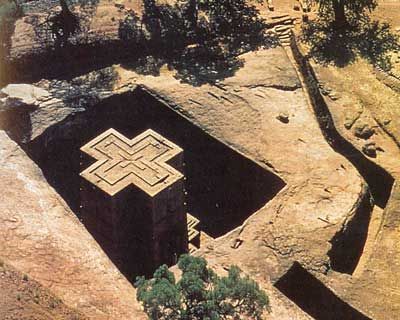About Lalibela Rock Churches Mystery | Ethiopia

Splendid churches, carved in the rock. Legends seem to indicate that the Ark of the Covenant passed this way.
History of Lalibela rock churches
Ethiopia is a mythical land crossed by a thousand mysteries and legends. At 2,600 meters above sea level lies what is known as the "Petra of Africa": Lalibela. Famous for its admirable rock churches, carved into the mountainside or into the ground, in the depths of the earth, it is the most sacred city after Aksum. There are ten churches and a small prison which no one knows when they were built. The founding of Lalibela generally dates back to the 12th century although its origin is certainly older. All the churches were built without any masonry element and without wooden structural parts, but exclusively by digging and carving the tuff rock. What makes it even more mysterious is that in this place, with the exception of churches, there are no other constructions from the same period. Legend has it that the shrines were built by order of King Lalibela after the ruler had a mystical vision. According to some researchers, it took 40,000 workers to build the entire complex, excavating the rock; however, the number of workers does not correspond to the actual population of this region during this historic time. According to another version, Crusader Knights, refugees in Ethiopia, would have controlled the construction of Christian churches.
Inside the 11 churches of Lalibela

The 11 churches of Lalibela are spread over two different sectors, with the sole exception of the church dedicated to Saint George (Bet Giyorgis). The largest group, located in the northwest, includes Bet Medhane Alem, the Church of the Savior, considered the largest rock church in the world. Within it are hollowed out stone niches that have been, in a totally anachronistic way, identified as the tombs of Abraham, Isaac and Jacob. This is also where Lalibela's most precious treasure is kept: a gigantic gold cross, weighing over 7 kilograms. One arrives, however, at Bet Maryam - Mary's Church - via a small stone arch in a rock face. Its plan is much more elaborate: the interior is made on two levels and there are numerous frescoes depicting Christian symbols as well as a strange two-headed beast fighting two bulls, one white and one black. Further on, a square-based pillar is covered with very thick sheets and fabrics, under which would be hidden a forbidden writing that no one can consult, except for a particular priest. According to local guides, the truth of the Ark of the Covenant is hidden within its sacred pages. Ancient and mysterious manuscripts bound in leather and bark are also believed to be kept in the tiny churches of Bet Meskel and Bet Danaghel. Moreover, for the Ethiopians, Bet Golgotha is the most sacred church: entry is closed to women and its walls are covered with frescoes depicting Crusader warriors on a war footing. The priest is also the guardian of a series of relics and especially of a small patch of land which is said to be holy.
On the other hand, the second group of churches, that of the south-east, is poorly preserved and difficult to access. Only the tiny prison, with its shackles and chains, raises various questions: who could well have been locked up in a site where there were only places of worship?
St George church
But Bet Giyorgis is, without a doubt, the most surprising church in Lalibela: it was made by digging, 15 meters deep, the rocky base of a hill. Dedicated to Saint George, its cross plan is developed on three levels, going more and more in depth. Even today, it is home to mystical hermits who live half-naked in its sacred niches, side by side with the skeletons that have been deposited there over the centuries. A very old chest and other sealed boxes are never opened in front of strangers, and no one knows what's in them. Some traces carved in the rock are attributed to the hooves of Saint George's horse, which manifested itself to reveal to King Lalibela a secret which remains well buried in the depths of the Earth.









































































































































































































































































































































